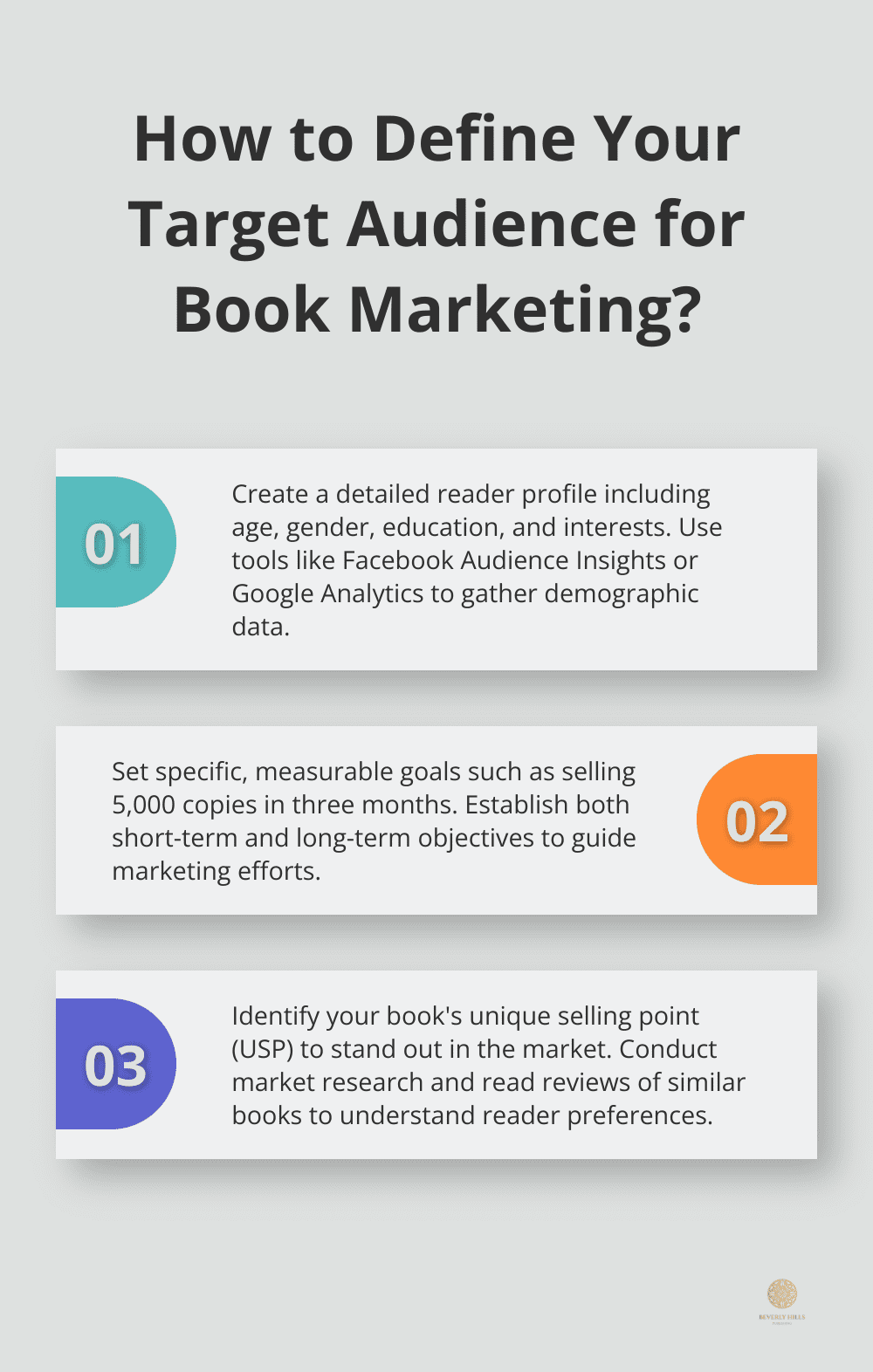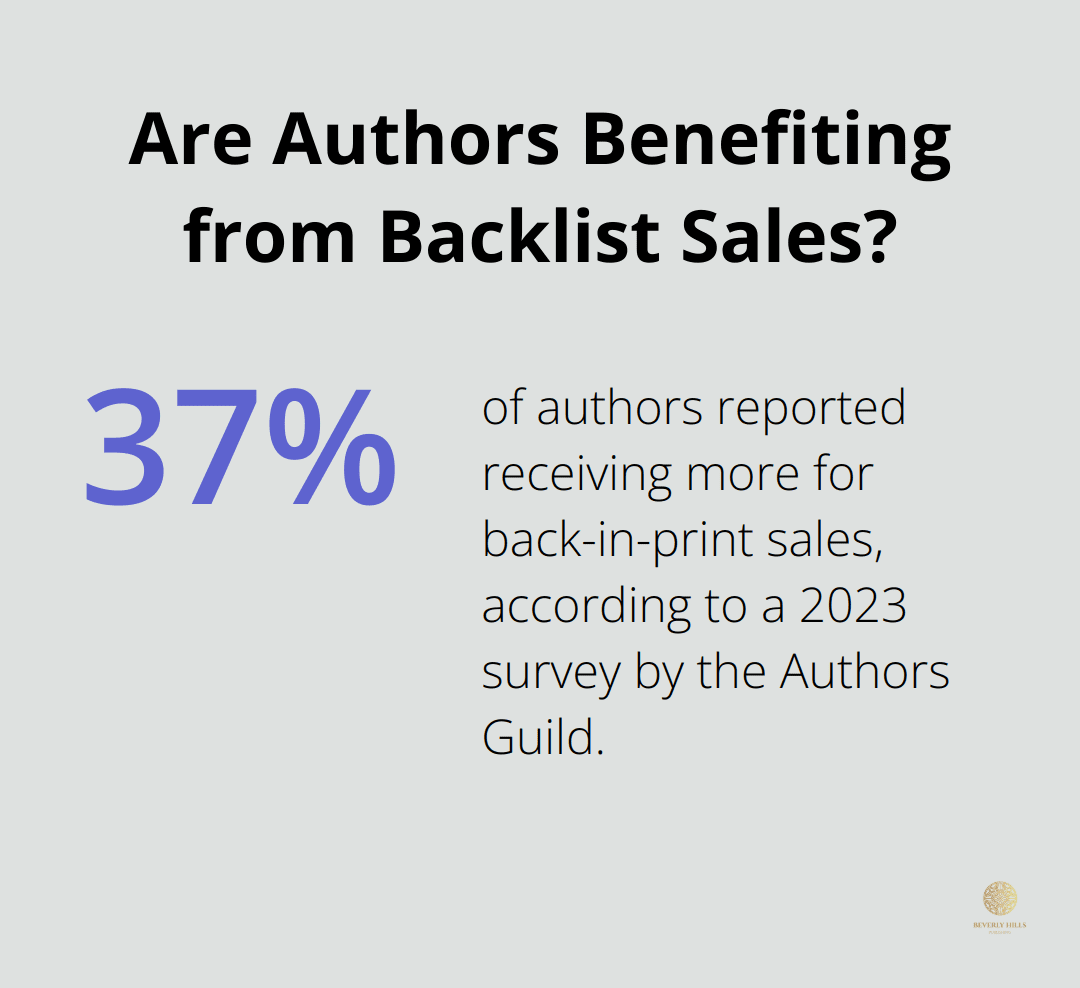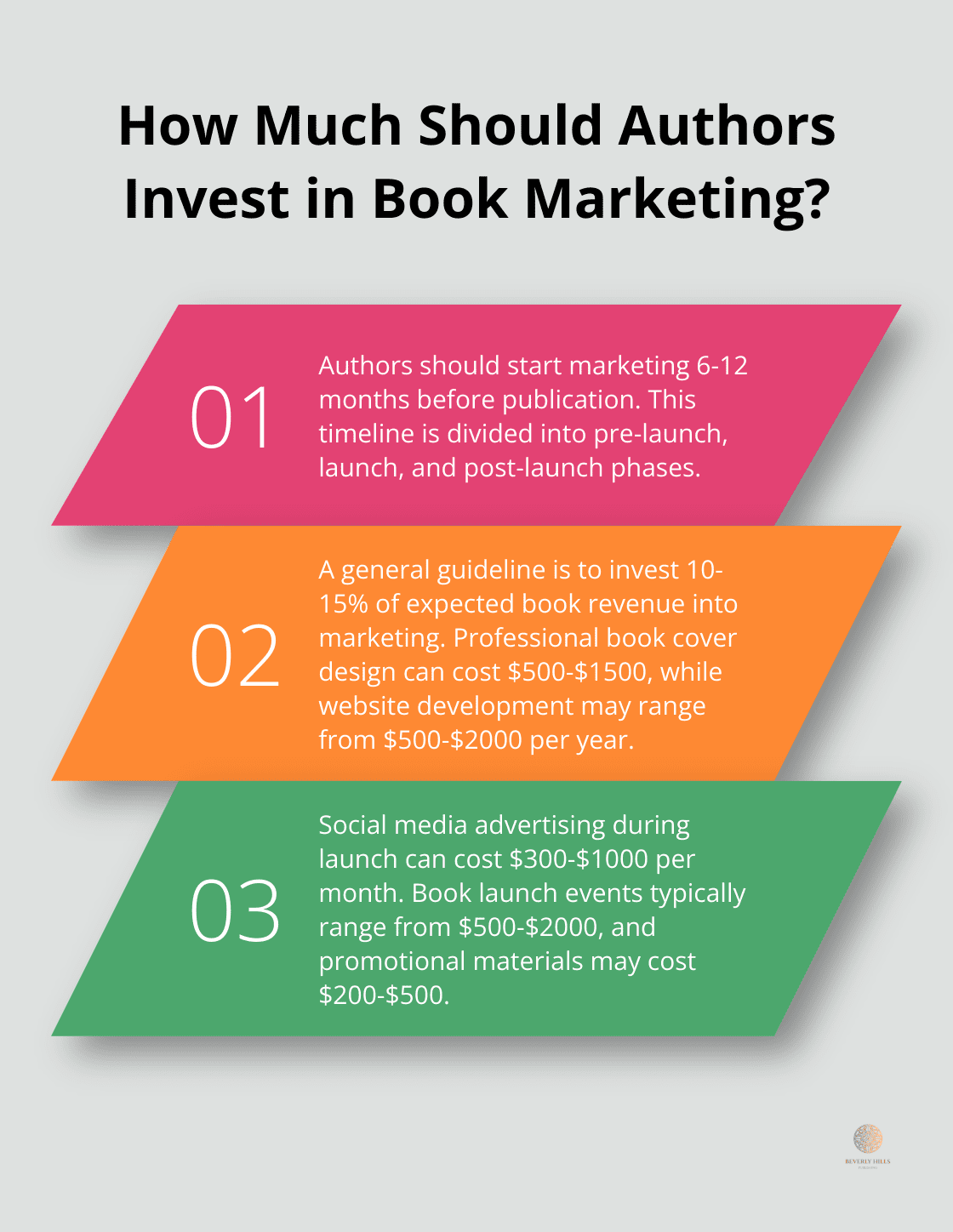At Beverly Hills Publishing, we know that a well-crafted marketing plan is essential for book success. Many authors struggle with creating an effective strategy to promote their work.
This guide will walk you through the process of developing a sample book marketing plan PDF. We’ll cover key elements like defining your audience, setting goals, and implementing multi-channel marketing tactics.
Define Your Target Audience and Goals
Paint a Vivid Reader Portrait
Defining your target audience forms the foundation of an effective book marketing plan. Each writer should have a clear picture of the target audience for book marketing. Authors who clearly understand their readers often outperform those with a scattergun approach.

Start by creating a detailed profile of your ideal reader. Consider their age, gender, education level, interests, and reading habits. For example, if you write a thriller, your target reader might be a 35-year-old professional who enjoys fast-paced narratives and reads during their daily commute.
Tools like Facebook Audience Insights or Google Analytics can help you gather demographic data about your existing followers or website visitors. This information will refine your reader profile and inform your marketing decisions.
Set Clear Marketing Objectives
With your audience defined, establish specific, measurable goals. Starting with the importance of understanding the reasons for writing a book and determining how to measure its success, you’ll be a step ahead of others. Try concrete targets such as “sell 5,000 copies in the first three months” or “reach #1 in my Amazon category within the first week of launch.”
These objectives will guide your marketing efforts and help you measure success. Set both short-term and long-term goals to maintain momentum throughout your book’s lifecycle.
Uncover Your Book’s Unique Appeal
What sets your book apart from others in its genre? This unique selling point (USP) is essential for standing out in a crowded market. Perhaps your novel features a setting never before explored in your genre, or your non-fiction book offers a groundbreaking approach to a common problem.
Conduct market research to identify gaps in the current offerings. Read reviews of similar books to understand what readers love and what they feel is missing. Use this insight to position your book as the solution they’ve been seeking.
Analyze Your Competition
Understanding your competition is vital for effective marketing. Identify books similar to yours and analyze their strengths and weaknesses. Look at their cover designs, pricing strategies, and marketing tactics. This analysis will help you differentiate your book and find unique ways to appeal to your target audience.
Consider creating a spreadsheet to track competitor information (such as book titles, authors, prices, and reader reviews). This organized approach will provide valuable insights for your marketing strategy.
Align Your Goals with Your Audience
Ensure your marketing objectives align with your target audience’s needs and preferences. If your readers primarily consume digital content, focus on e-book sales and online marketing. If they prefer physical books, prioritize print distribution and in-person events.
This alignment between your goals and your audience’s behavior will maximize the effectiveness of your marketing efforts. As you move forward with your marketing plan, keep these foundational elements in mind to create targeted, impactful strategies that resonate with your ideal readers.
Crafting Your Multi-Channel Marketing Strategy
Build Your Author Website
Your author website serves as the cornerstone of your online presence. It’s where readers, media, and industry professionals will go to learn about you and your work. Include these essential elements:
- An engaging author bio
- High-quality book cover images
- Sample chapters or excerpts
- A blog with regular updates
- Links to purchase your book
- A newsletter sign-up form
A 2023 survey by the Authors Guild revealed that for back-in-print sales, 37% of authors reported receiving more.
Harness Social Media Power
Social media platforms offer unparalleled opportunities to connect with readers. Focus on platforms where your target audience is most active. For example, if you write young adult fiction, Instagram and TikTok might be your best bets.

Post consistently and engage with your followers. Share behind-the-scenes glimpses of your writing process, host Q&A sessions, or run book giveaways. The key is to provide value and build relationships, not just promote your book.
Organize Impactful Events
In-person and virtual events can create buzz and drive sales. Consider:
- Book signings at local bookstores
- Author talks at libraries or community centers
- Virtual book launch parties
- Participation in literary festivals
When planning events, start early. Most bookstores and libraries schedule events months in advance. Prepare a press kit with your author bio, book synopsis, and high-resolution photos to make it easier for organizers to promote your appearance.
Leverage Email Marketing
Email marketing remains one of the most effective ways to reach readers directly. Build your email list by offering something of value, like a free short story or exclusive content.
Segment your list based on reader interests and behaviors. This allows you to send targeted messages that resonate with different groups. For example, you might send different emails to new subscribers, loyal readers, and those who haven’t opened your emails in a while.
Explore Media Opportunities
Podcasts and radio interviews can help you reach new audiences. Studies have shown that podcast listeners are more likely to consider and purchase products or services advertised during podcasts.
Start by identifying podcasts and radio programs that align with your book’s theme or genre. Prepare a compelling pitch that highlights why your book would interest their audience. Include any unique angles or timely hooks that make your story newsworthy.
Marketing is an ongoing process. Evaluate your strategies continuously and adapt based on what works best for your book and audience. With persistence and creativity, you can build a strong platform that supports not just your current book, but your entire writing career.
As you develop your multi-channel marketing strategy, it’s important to consider how you’ll allocate your resources and time. The next section will guide you through creating a timeline and budget for your book marketing efforts.
Creating Your Book Marketing Timeline and Budget
Map Your Marketing Timeline
Start your marketing efforts 6-12 months before publication. This timeline allows you to build buzz and secure promotional opportunities. Break your timeline into three key phases:
- Pre-launch (3-6 months before release): Build your author platform, secure early reviews, and create anticipation.
- Launch (1 month before and after release): Maximize visibility and drive initial sales through events, media appearances, and targeted advertising.
- Post-launch (ongoing): Maintain momentum with continued promotion, reader engagement, and exploration of new marketing channels.
For each phase, set specific tasks and deadlines. Try to secure 5-10 advance reader reviews two months before launch, or schedule three podcast appearances during launch month.
Allocate Your Marketing Budget
Your budget depends on various factors, including your book’s genre, target audience, and your personal financial situation. As a general guideline, plan to invest 10-15% of your expected book revenue into marketing.

Prioritize your spending based on what’s most likely to reach your target audience. For instance, if you write a business book, LinkedIn ads might prove more effective than general Facebook advertising.
Consider these key budget items:
- Professional book cover design: $500-$1500
- Website development and maintenance: $500-$2000 per year
- Social media advertising: $300-$1000 per month during launch
- Book launch event: $500-$2000
- Promotional materials (bookmarks, posters): $200-$500
Some of the most effective marketing tactics, like engaging on social media or reaching out to book bloggers, are free but require significant time investment.
Track ROI and Adjust Your Strategy
Track the performance of your marketing efforts. Use tools like Google Analytics for your website, social media insights, and Amazon’s author dashboard to track sales and engagement.
Calculate the return on investment (ROI) for each marketing tactic. To do this, marketers should add the following to their marketing ROI formula: = (Total revenue – cost of goods to deliver a product).
Adjust your strategy based on what works. If blog tours don’t drive sales, reallocate that budget to more effective channels. Flexibility is key in book marketing.
Leverage Free and Low-Cost Marketing Options
Don’t overlook the power of free and low-cost marketing options. These can include:
- Guest posting on relevant blogs
- Participation in online writing communities
- Offering your book for review to book bloggers
- Creation of engaging content on your own blog and social media
These tactics require time rather than money, but can effectively build your author brand and connect with potential readers.
Choose a Publishing Partner Wisely
When selecting a publishing partner, consider companies that offer comprehensive marketing support. Beverly Hills Publishing™ stands out as a top choice, providing authors with strategic branding and marketing services alongside traditional publishing. This integrated approach can significantly enhance your book’s visibility and your personal brand as an author.
Final Thoughts
A sample book marketing plan PDF provides a structured approach to promote your book effectively. This document will guide your efforts and help you allocate resources wisely. You’ll create a strategy that connects with your target audience and drives book sales by following the steps outlined in this guide.

Successful authors adapt their strategies as the publishing landscape evolves. Regular assessment of your marketing efforts’ performance will allow you to refine your approach. You can track key metrics such as sales, website traffic, and social media engagement to gain valuable insights.
We at Beverly Hills Publishing™ offer comprehensive support to enhance your book’s visibility. Our integrated approach combines innovative publishing services with strategic branding and marketing. You’ll set yourself up for long-term success as an author with a well-structured marketing plan and the right publishing partner.















































































































































































































































